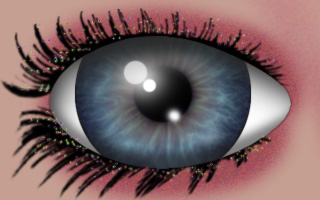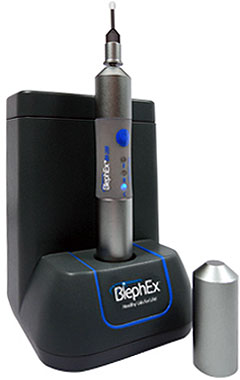 |
Blepharitis
Blepharitis is an inflammation of the
eyelid, along the eyelash line. The condition is not fully
understood by doctors, but there are several causes associated
with blepharitis as well as a range of treatments.
Viruses, bacteria, mites and problems in the oil glands of the
eye are all linked to blepharitis. Certain kinds of medication
such as those used for severe cases of acne can also cause
blepharitis.
Blepharitis is not conjunctivitis, or “pink
eye”, although the two may occur at the same time and display
similar symptoms. |
NEW In-Office Treatment
- BlephEx!
We know how prevalent
Blepharitis is among patients.
Now we can
treat you right in our office!
BlephEx is a
medical device used in the fields of ophthalmology and optometry
to treat blepharitis and dry eye disease. The handheld device is
used by a doctor to exfoliate the eyelid at the lash line and
remove the inflammatory biofilm that leads to chronic lid
disease and discomfort.
It is a painless
in-office procedure performed by your eye care professional. A
revolutionary new patented BlephEx™ hand piece is used to very
precisely and carefully, spin a medical grade micro-sponge along
the edge of your eyelids and lashes, removing scurf and debris
and exfoliating your eyelids.
The patented micro-sponge
is disposable and a clean one is used for each individual eyelid
so bacteria is not spread between the lids. The eyes are rinsed
well afterwards.
The procedure lasts about 6 -8 minutes
and is well tolerated. Most patients simply report a tickling
sensation. A numbing drop is usually placed in each eye prior to
treatment for increased comfort.
Afterwards, patients
experience a near immediate resolution of their symptoms and you
will be extremely happy to finally be free of the chronic
irritation and eye rubbing that you may have suffered with for
many years.
|
 |
| |
|
Until now, your only options have been to try
different drops, artificial tears and/or home lid scrubbing.
Now, we can take charge of this chronic irritating disease
process because we know you depend on us for the latest in eye
care treatment.
|
| |
|
 |
Studies have shown that up to 35% of all patients have
some type of blepharitis symptoms and would benefit from
BlephEx™. That number increases to over 70% in patients
over 65.
• BlephEx™ is a new,
in-office procedure that allows your doctor to take an active
role in treating blepharitis.
• BlephEx™ reduces scurf and
bacterial debris, the main causes of inflammatory lid disease,
and improves the overall health of the eyelid.
• Patients will
finally enjoy a life free from the chronic and irritating
symptoms associated with blepharitis.
• The BlephEx™ treatment
is well tolerated and only takes a few minutes to perform.
• BlephEx™
can save the patient hundreds of dollars in the costs of
prescription drops and artificial tears.
• See your eye doctor todayforr the latest in eyecare technology, and see if BlephEx™ is
right for you. |
|
| |
There are two basic types of blepharitis - Anterior
blepharitis and Posterior blepharitis:
»
Anterior Blepharitis
There are many kinds of anterior blepharitis.
Anterior blepharitis is the name of an inflammation that affects the
outside part of the eyelid around the base of the eyelashes. Bacteria,
mites and viruses can all cause anterior blepharitis. Three kinds of anterior blepharitis are
staphylococcal blepharitis, demodex blepharitis and seborrheic
blepharitis.
° Staphylococcal blepharitis:
This inflammation is
caused by the bacteria Staphylococcal growing along the eyelash line.
° Demodex blepharitis:
Mites and their waste can clog the roots
of the hair follicles of the eyelashes. Everyone has tiny mites that
live in their eyelashes, but only some people experience an infection.
Researchers speculate that an unusual immune response or allergies might
cause some people to be affected by demodex blepharitis and not others.
A different kind of demodex mite can cause posterior blepharitis when
the mites enter the oil glands of the eye.
° Seborrheic
blepharitis:
This type of blepharitis is caused by seborrheic
dermatitis - a skin condition characterized by flaking and
scaling of the skin.
» Posterior Blepharitis
There are also a few different kinds of posterior blepharitis. Posterior blepharitis refers to blepharitis of the eyelid
at the point where it comes into contact with the eyeball.
° Meibomian blepharitis:
Oil glands in
the eye are called the meibomian glands. These glands sit behind the
eyelashes and are responsible for giving the skin around the eyes a
healthy amount of lubrication. Meibomian blepharitis occurs when these glands function
improperly.
° Rosacea blepharitis:
Rosacea is associated with dysfunction of the meibomian glands as well,
resulting in inflammation of the eyelid.
Diagnosis
A diagnosis of
blepharitis can be made during a complete eye exam. Observation of the
condition of the eyelid and eyelash line should be enough to make a
diagnosis.
Patients who wear contacts may have to temporarily
discontinue their use of the lenses until the inflammation goes away. If
a patient used any eye makeup products while they were experiencing
blepharitis, the products should be thrown away in case they were
contaminated.
Warm compresses can help with the symptoms of
blepharitis. Soaking a washcloth in warm water and leaving it across the
eyelids for five minutes can loosen any crustiness that builds up at the
base of the eyelashes and loosen any debris clogging the oil glands. You
can gently massage the eyelids as well. Always be very careful when
touching your eyes and be sure not to put too much pressure on your
eyeball.
Blepharitis can re-occur in patients over
their lifetime.
Please contact us today to discuss the appropriate
lid scrub products required to successfully manage your personalized lid hygiene. |
|
Prevention
Strict eye hygiene helps prevent blepharitis. Using clean towels and
making sure your hands are clean before touching your eyes and eye area
are important steps in prevention. If you wear makeup, it is important
to thoroughly remove any traces of it before going to bed.
In
cases of posterior blepharitis where the oil glands are not producing
enough oil, nutritional supplements of Omega-3 fatty acids may be
recommended by your doctor.
Discuss with your doctor about the best omega 3
supplements to take for your condition.
When to
see an eye care professional
If you experience any of the
common blepharitis symptoms, it is time to make an appointment with your
eye care professional. Blepharitis can cause itching in the eye,
redness, crustiness at the base of the lash line and general irritation.
You may also feel a foreign body sensation in the eye. This can feel
like a piece of sand in the eye or grittiness on the eyeball that
doesn’t go away. In some cases of blepharitis, the eyes may become more
sensitive to light.
Always see a medical professional immediately
if you have any sudden changes in vision. This includes darkening around
the edges of your vision, dark spots in front of your eyes, halos around
bright lights, a loss of vision in one part of your field of sight or
any other noticeable change.
|